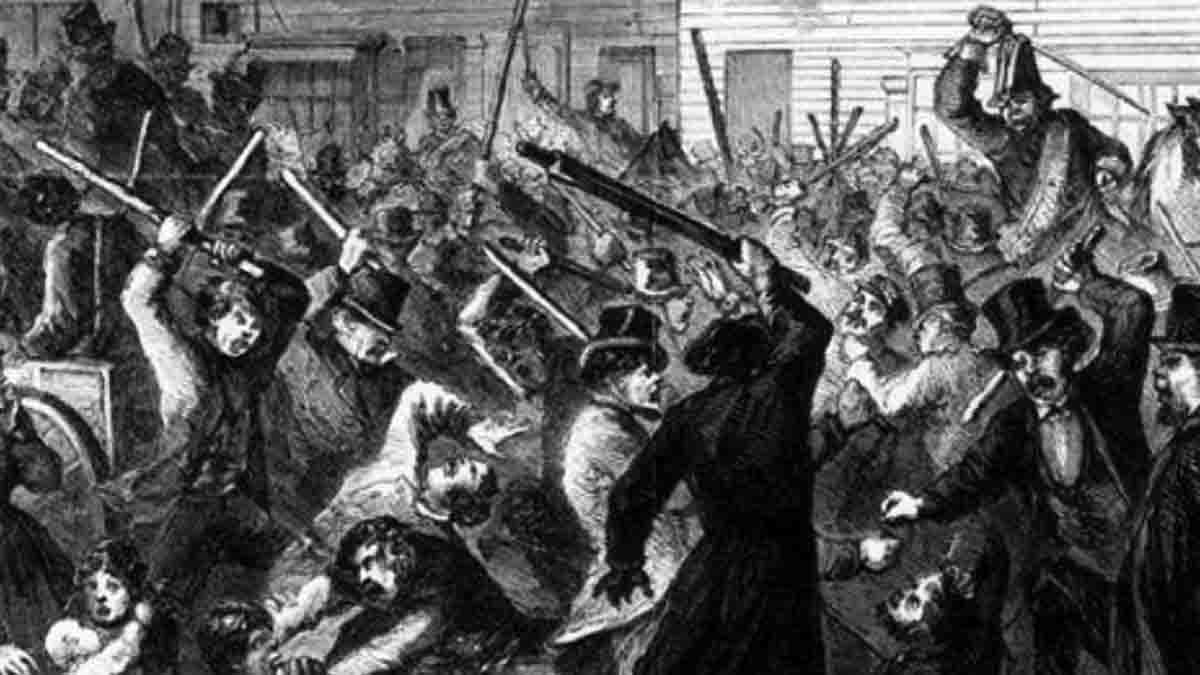BY JOHN FITZGERALD
(PART ONE)
Pre-famine Ireland could be a dull, uneventful place. People led simple lives and regulated their existence in accordance with the cycle of nature.
But they had own diversions and social outlets, and one event, above all, was guaranteed to liven up a town or village and bring crowds from miles around: the local faction fight. Rival groups could be clans, families, or whole parishes; pitted against each other over any obscure cause, insult, or imagined insult.
The more prominent opposing factions had names such as the Bogboys and Tubbers, Caravats and Shanavests, or the Black Hens and the Magpies. They met at fairs, patterns, and other suitable venues to engage in pitched battles.
The violence could be haphazard and spontaneous, but more often it was planned and directed by the participants.
The numbers of combatants could run to hundreds, or even thousands. An impressive variety of weapons were used. Skilled wood workers sculpted the faction sticks from blackthorn, holly, and ash. The “leaden butt” was favoured by some fighters. It was a whip handle fortified with lead.
Faction fighting gave us many of the old sayings that we take for granted. “T’would bate Banagher and Banagher bate the band”, for example, dates to a notorious fight in the County Offaly town in 1814. A notice from the neighbouring parish of Lusmagh appeared on walls all over the town, challenging the fighters of Banagher to a duel.
It stated: “We, the parishioners of Lusmagh, give notice to the town of Banagher that we will go in on Thursday next and give them battle. Ye may be assured that there is not a man among ye between the age of 12 and 60 that must not turn out.” The notice was signed “Captain Stout.”
On January 6th, 1814, the factions met and a ferocious struggle ensued. A Lieutenant Cruise of the 12th regiment stationed near the town reported to HQ: “As soon as we arrived to disperse this atrocious mob, we were pelted with stones. The contending parties were the inhabitants of Banagher and of the parish of Lusmagh, the latter to the amount of 500, who had come in with the intention of beating Banagher.”
Callan witnessed many such contests, and His Majesty’s police force faced a major challenge in its bid to suppress them. Locals made their own rules, based on a traditional code of homegrown ethics, and a willingness to cooperate with the Authorities was not high on their agenda.
In Callan, warring factions confronted each other on a regular basis in the 1820s and 30s. While class distinctions played a part in the contests, it appears that the various gangs needed little provocation to “get stuck in.” Almost any dispute, however minor, could set the fuse to a tinderbox.
One such dispute in November 1838 concerned the alleged stealing of a pig by a woodcutter. Sean Denton was wrongly suspected of removing a pig from the farm of Patrick McNiff after a third man, Edmund Barry, claimed that Denton committed the offence.
Barry was under the influence of alcohol at the time he made the allegation. He had consumed an estimated fourteen pints of ale at the Red Lion tavern in Callan when somebody mentioned the woodcutter’s name.
Barry had a long-standing grudge against Denton, and now saw his chance to discredit him. He suggested to his fellow drinkers that Denton had been seen running from McNiff’s farm with the pig under his arm.
The gossip machine cranked into motion and word spread like wildfire through Callan. Sean Denton was beside himself with rage when he learned of the malicious rumour and who had started it.
A one-to-one fistfight might have seemed the reasonable way of resolving the issue. But this was Callan of the Factions. Four years earlier, on September 3rd, 1834, the Caravats and Shanavests had turned the town into a battlefield.
The factions had to be driven off the streets by armed troops and police. The sight of fixed bayonets only enraged the fighters, sparking off riots, extensive damage to property and hundreds of injuries.
Denton challenged Barry and all his followers to a showdown. Denton would confront his hated enemy on the Fair Green, he swore, and “break a thousand bones” before the day was over. He set about gathering his friends and relatives in the area for a council of war.
42-year Denton had graduated in 1821 from the Callan School of Faction Fighting. Such schools were common in the 1820s. Though of slight build, he excelled in stone throwing and the combative use of blackthorn sticks.
Barry was 35, stood six feet in height, and was powerfully built. He claimed to have delivered more knockout blows in faction fights “than any man alive.” He also boasted of having killed a bull with his bare hands, but the creature was never produced in evidence to support his claim.
Callan sizzled with tension as the big showdown loomed…
To be continued…
(My book Callan in words and pictures is available from Amazon)




















